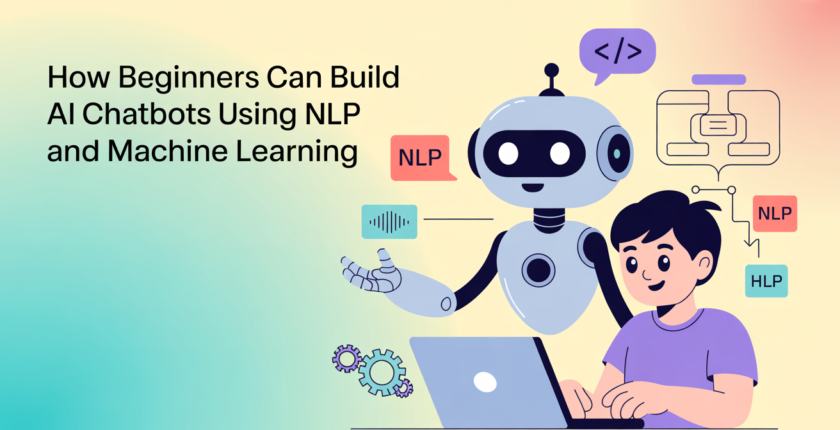AI-Powered Chatbots: How Beginners Can Build Conversational Bots Using NLP & Basic Machine Learning
AI-Powered Chatbots: Chatbots now run help desks, shopping assistants, campus assistance, and interview coaches across industries, proving that conversational AI is more than just science fiction. Building an AI-powered chatbot is a great way for novices to learn the fundamentals of machine learning, dialogue design, and natural language processing (NLP). The best part is that with today’s readily available tools and prebuilt models, you can build a functional bot without being an expert in deep learning.
This manual outlines a precise, methodical process for creating, honing, testing, and implementing a chatbot. Define scope, gather and label basic data (entities & intents), decide between rule-based and machine learning techniques, set up an NLP pipeline, control context, and incorporate the bot into actual channels. Every stage is described with helpful tips and ideas for beginners.
I’ll stress best practices throughout: monitor production behavior, validate all AI outputs, maintain user privacy, and keep the bot’s scope narrow. While building, bear the following keywords in mind: intent classification, dialogue management, AI chatbot tutorial, NLP for beginners, how to develop a chatbot, and chatbot deployment.
Step-By-Step Procedure (key points — each explained in two paragraphs)
1) Define the purpose & scope
First, respond to two questions: what issue should the chatbot address? Moreover, who is the user? A clear objective keeps the project manageable and increases accuracy (e.g., order tracker, interview prep assistant, campus FAQ bot). Prioritize the mapping of success measures, such as the proportion of resolved requests, user happiness score, fallback rate, and answer accuracy.
Early scope limitation also influences technical decisions. A support bot may require entity extraction and backend interaction, but a FAQ bot can primarily be retrieval-based (matching inquiries to pre-written replies). Start with one vertical and 10 to 30 common user questions for novices; after the fundamental flows are solid, you can grow.
Novorésumé 16 ATS Friendly resume Templates to to Land Your Dream Job
2) Design conversation flow & UX
Create dialogue flows for the most typical user journeys, which include greeting, intent detection, fulfillment, and closing. Include multiple fault paths (for situations where the user is unsure or the bot does not reply) as well as the “happy path” (the ideal flow). Make use of resources such as Miro, draw.io, or basic whiteboard drawings.
Confirmations for risky actions, courteous fallbacks (“I’m not sure I understood — can you rephrase?”), and methods to transfer off to a human are all components of good user experience. Create the bot’s personality and tone (formal, informal, encouraging) so that the language used in system messages and prompts is consistent.
3) Collect and prepare training data (intents & entities)
Make a list of the user’s intents (such as “apply_internship” or “check_deadline”) and write many sample utterances for each intent (10–30 examples is a good place to start). Additionally, specify the entities (slots) that you need to extract, such as order IDs, dates, or course names.
Carefully label and tidy the data. Make use of CSV or JSON formats that Dialogflow and Rasa support. In order to prevent hallucinated information that could confuse the model, you can first enhance data by paraphrasing examples (either manually or with AI). However, you should constantly validate augmented examples.
4) Choose architecture & tools (rule-based vs ML vs hybrid)
Determine if a rule-based, machine learning-based, or hybrid strategy is appropriate for your needs. For small, deterministic domains, rule-based bots (if/else, regex) are straightforward and dependable. Logistic regression, transformers, and tiny neural nets are examples of machine learning intent classifiers that generalize well to different wording. A hybrid approach is used in many successful projects: rules/policies for final actions and machine learning for intent detection.
Platforms for beginners: Botpress and IBM Watson Assistant are substitutes; Rasa is open-source and offers control over NLU + dialogue policies; Dialogflow (Google) and Microsoft Bot Framework offer controlled intent classifiers and channel connections. You can incorporate an LLM (OpenAI, Hugging Face) if you desire generative capabilities, but use it sparingly (see hallucination danger).
5) Build the NLP pipeline (preprocessing → embeddings)
Lowercase, eliminate punctuation if necessary, and possibly normalize tokens (numbers, dates) are examples of basic preprocessing. For more reliable matching, you can utilize prebuilt sentence embeddings like SentenceTransformers or bag-of-words/TF-IDF for tiny bots or embeddings (Word2Vec, FastText) for intent classification.
In order for similarity search (cosine similarity) to return the best prepackaged response, embeddings convert phrases to vectors. Hugging Face’s sentence-transformers allow you to embed utterances and execute a nearest-neighbour lookup for retrieval bots, but many platforms abstract this away.
6) Train intent classifiers and NER (named entity recognition)
Use your tagged utterances to train a basic classifier (a tiny neural network or scikit-learn logistic regression). Cross-validation and metrics such as accuracy and F1-score should be used for evaluation; keep an eye on per-intent performance as rare intentions can require additional samples.
Add a NER model if your bot requires slot filling (names, dates, and IDs); Rasa has NLU with integrated entity extraction, and SpaCy provides pipelines that are easy for beginners to use. Verify that the extracted entities are accurate in context at all times; misextracted slots result in unsuccessful tasks and irate users.
7) Implement dialogue management & context handling
The management of the dialogue makes the next decision. Rule flows or finite state machines can be used by simple bots. Use a stateful manager that saves session variables (user id, collected slots) for context-rich interactions (multi-turn bookings, order status).
Forms, follow-ups, and fallback policies can be defined using advanced frameworks (such as Dialogflow contexts, Rasa policies, or Bot Framework Dialogs). Create the dialogue in a way that allows the bot to politely inquire for missing information and to re-ask questions that are broken without losing context.
8) Integrate backend systems & fulfillment
To satisfy user intents, connect your chatbot to databases, CRMs, or APIs (e.g., obtain order status, book slots, save lead info). Use scalable, secure integrations by utilizing RESTful webhooks. For instance, the bot should utilize the user ID to call a backend endpoint and deliver the answer when a user requests, “Check my application status.”
Secure integration involves sanitizing outputs, validating inputs (to prevent injection), and authenticating API requests. Simple JSON files or dummy APIs are OK for student projects; for production, use genuine credentials, rate-limit calls, and gracefully handle errors.
9) Test extensively (automated + human testing)
Make unit tests for dialogue flows (scripted scenarios) and NLU (intent confusion matrices). Utilize automated test suites (Dialogflow test cases, Rasa tests) and execute them following modifications. Prioritize improvements by keeping an eye on top confusions and fallback rates.
In order to log edge cases and get peers to converse with the bot in a natural way, human testing is crucial. Examine transcripts, track assignment completion, and make adjustments. Adoption is frequently more negatively impacted by minor UX problems (ambiguous prompts, tone mismatch) than by model correctness.
Must-Know AI Tools Freshers, Students, and Job Seekers in 2025
10) Deploy, monitor, and iterate continuously
Install your bot on the chosen channels (web chat widget, WhatsApp, Slack, and Messenger). Use monitoring and logging to obtain data on errors, discussions, and user satisfaction. Platform-built analytics, Sentry, Kibana, and other tools can be used to detect regressions and misuse.
Iterate by enhancing dialog policies, retraining models with new utterances, and conducting A/B testing for backup plans or wording. By displaying privacy information, respecting opt-outs, and keeping only the user data that is necessary—especially when handling personal data—you can also prepare for compliance.
Final tips & resources
Ethics & privacy: avoid storing sensitive data unnecessarily; implement consent flows for transcripts and analytics.
Start small and iterate. A polished FAQ bot is better than an unfinished “clever” bot that fails often.
Use managed platforms for faster results (Dialogflow, Rasa for control). If you use LLMs (OpenAI/GPT), guard against hallucinations; prefer retrieval+generation hybrids.
Measure what matters: task completion, fallback rate, user satisfaction, and average response time.



